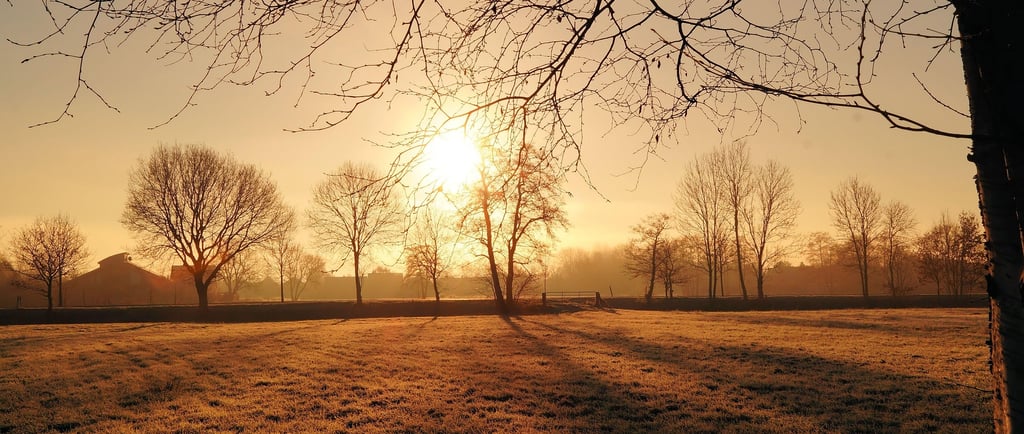🌳 The Secret Life of Trees in Winter ❄️
🌳 A follow-up story that connects The Plant and Ecology chapters in the Biology Album. 🌿✨ It invites children to uncover the secret life of trees during winter—how they conserve energy, slow their processes, and communicate underground using special network. 🌱🕸️ Even as the branches rest, the roots—the water seekers—never stop their quest for nutrients, working year-round beneath the frost-covered soil. ❄️🌱 This story connects to other plant adaptations and the vital relationships between living organisms, sparking wonder: “How do trees know when to wake up after their long winter rest?” 🌞💭
BIOLOGY STORIES
1/30/20253 min read


When winter comes and the forest turns quiet, have you ever wondered what happens to all deciduous trees? 🌳 Do they fall asleep, or are they secretly busy preparing for something magical?
In spring and summer, deciduous trees are full of life—green leaves waving, birds chirping from their branches, and bees buzzing around their blossoms. 🐦🐝 But when autumn arrives, their leaves turn golden, fall to the ground 🍂Just as their Latin name promises - decidere, meaning “to fall off”. Suddenly, all deciduous trees seem to go to sleep. Or does it? 🌬️👀
Even without their leaves, trees are far from sleeping! Right opposite, they’re saving energy and quietly preparing for their big spring comeback. 🌱 Their roots dig deep underground, searching for water and minerals. Think of the roots as water seekers —they keep seeking and sipping water, even when the surface of the ground is frosty. ❄️💧 The tree stores this water in its trunk and branches, waiting for warmer days to return.
But how do trees survive freezing temperatures? They have their own version of a cozy winter jacket! 🌳🧥 The bark on the outside of the tree acts like insulation, keeping the inside warm and safe. Underneath, the tree has slowed down its work because the food factories—the leaves—are not working. And just like animals hibernate and slow down in the winter months , the sugary liquid made by the leaves during warmer months thickens like syrup and moves more slowly, helping protect the tree from freezing.🌡️🍁But trees like the sugar maple, holds a sweet secret! 🍯 As winter fades and temperatures hover around freezing —usually in late February or March—the tree starts to “wake up,” and the sap begins to flow smoothly. 🍃🌞 People tap the tree by placing small spouts into its trunk to collect the sap (like in the first photo!). 🌳💧They sometimes tap entire maple forest.
This is not an easy job! 🤯 You may think that you tap and here comes the sweetest maple syrup. Not really! It takes 40 liters of sap to produce just 1 liter of the maple syrup you know 🍁 ! 🤯 That’s like filling a large bathtub 🛁 with sap just to make a single bottle of syrup! Once gathered, the sap is boiled down to create the sweet, sticky sweet maple syrup you know and love. 🥞✨ In colder regions like Canada 🇨🇦 , people even pour hot syrup over snow to make maple taffy—a delicious winter treat, a gift from the maple tree . 🍬❄️ Yum !😋
Now, back to my wondering question about the sleeping trees during the winter. Scientists have found that trees also communicate like us, but they do it secretly - underground! 💬 🌱✨ They chat with the help of their roots and fungi networks called mycorrhizal networks 👏 my 👏 cor 👏 rhi👏 zal 👏. They can send messages to each other about where to find water or warn of danger. This name comes from Greek words meaning “fungus-root networks”. 🕸️ These fungal threads allow trees to “whisper” to each other, share nutrients, and warn about threats. Scientists even call this the “wood-wide web”! 🌍🕸️Like the man made world-wide-web 🌐 stretching cables or satelites all over the globe to ensure that we can communicate with each other without being next to each other!
Some trees, like evergreens, keep their green needles during winter.🌲 Their needles have a waxy coating that helps lock in moisture and prevent water loss.As winter begins to fade, evergreen trees start growing new soft, fresh, light green, easy to spot tips . 🌱✨ Meanwhile, other trees, like deciduous trees (from the Latin word decidere, meaning “to fall off”), such as oaks and maples, birch and acorn, shed their leaves in autumn to save energy and preventing the food factories from deeply freezing. ❄️🍁 This clever strategy helps them survive the cold months and prepare for their spring regrowth! 🌳
So, while it might seem like nothing is happening in the park or forest during the winter, trees are quietly hard at work. 🌳❄️ They’re resting, storing energy, and patiently waiting for their moment. As the Sun returns, the days grow longer, and the signs of spring emerge, they’re ready to burst with new leaves, blossoms, and life once again. 🌞🌸🌱 🌷✨
❓ I wonder…💭 How do trees know when it’s time to wake up and join the spring celebration? Do they feel the warmth of the sun, or they hear the birds chirping loudly? Or there it something happening deep inside their roots? 🌞🌱✨
With Montessori joy,
Vanina 😊a

